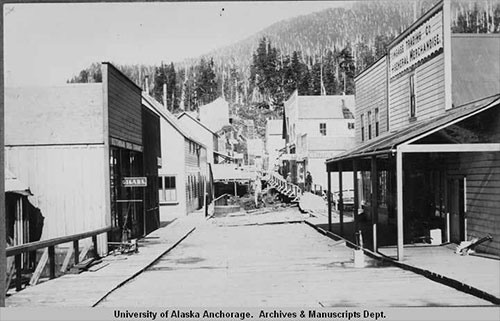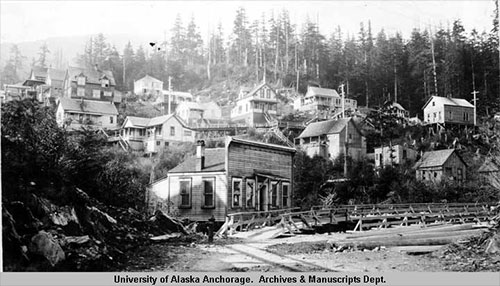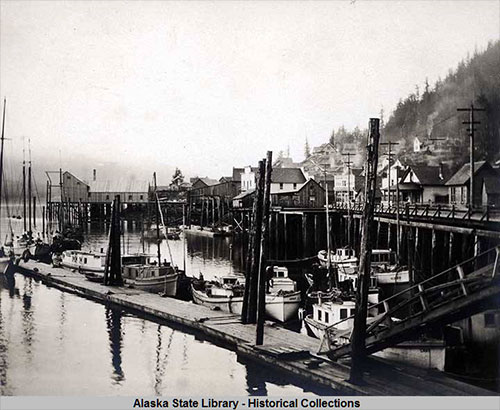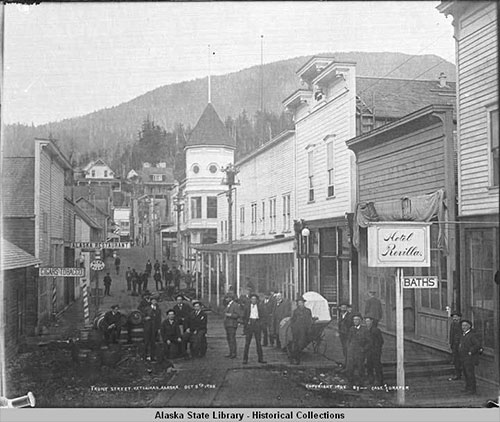Ketchikan's rainfall notoriety goes way backIn 1916 Visiting Writer Dubbed First City 'The Rainiest Town'By DAVE KIFFER April 05, 2021
And despite its efforts to market itself as other things, such as the Salmon Capital of the World, it has certainly been nationally known as the rainfall champion since the late 1940s ( See "When Did Ketchikan Become the Rainfall Capital," SITNEWS, August 17, 2017) Or maybe even earlier?
How about this headline from the January 12, 1916 edition of the international weekly magazine "Christian Herald" published in New York City. "Ketchikan: The Rainiest Town in America." (pdf) The Herald was certainly international in scope with stories in that issue about the recent changes in China as it went from empire to republic, the World War in Europe, and a variety of stories on religious life in America and elsewhere. But it also had a travel section and that month it was featuring Frank G. Carpenter's "Travel Story of Alaska." Arriving by steamship, Carpenter naturally noted that it was a challenge differentiating Ketchikan and the Alaskan Panhandle from British Columbia from which it appeared to be "cut from." He noted that Ketchikan was in a "marine paradise."
"I sailed for more than 500 miles through Canadian waters to Revillagigedo Island on the shores of which Ketchikan lies," Carpenter wrote. "The trip took me more than two days and the fare was $22." His descriptions of the Inside Passage were particularly rapturous. "I despair of giving you any ideas of the beauties of this voyage," he wrote. "There are all sorts of combinations of sea and sky, of evergreen slopes and snow-capped mountains, the color effects are beyond description and the sunsets indescribable in the changes and beauties." And then he arrives in Ketchikan, which he describes as "an American town on piles." "The houses are built on the rocks," he wrote. "It has no beach to speak of and the business part of the town rests upon piles. The streets are planked roadways upon posts and much of the freight is carried about on trucks and carts pushed by men. There are several drays hauled by horses, but horses are unpopular for their shoes roughen the planks and they shake the town as they trot through the streets." Carpenter noted that the houses are "high on the cliffs above the harbor." "It is so steep you have to climb stairways to reach certain streets," he wrote. "The Ketchikaners make you think of the tree dwellers, who have to climb ladders to get to their homes."
He also noted that the were more than a few gardens, despite the near complete lack of soil because "the hills are so steep the soil runs off with the rain." He repeated a story he heard from the captain of his steamship on the way up. How a previous passenger was upset because he had forgotten something important to bring back from Seattle for his wife. "She made me promise to bring back seven sacks of good soil to lay on the rocks and make her a garden," the man told the captain dejectedly. "I knew I'd forget. And I forgot it. I forgot it." Carpenter reported that the garden of H.C. Strong had "raspberry bushes as high as my shoulder."
He asked Strong a question that has become a common one for all Ketchikan residents and Strong gave him a common - somewhat facetious - response. "Does it ever stop raining in Ketchikan?" "I hardly know," Strong replied with a laugh. "I have lived here only 15 years." Strong was one of the Ketchikan pioneers, helping to build the Fidalgo Island Cannery and Citizen's Power and Light (the forerunner of KPU) (See "Henry C. Strong, SITNEWS, August 10, 2006). Carpenter noted that the southern coast of Alaska was one of the rainiest parts of the world and that Ketchikan was "blessed" with up to "11 feet of rain" each year. "Here, people go about regardless of the rain," he wrote. "They wear rubber coats or slickers and if they tramp up the mountains, they put on rubber boots that reach up the waist." He also noted the constant use of "oilskins." "No one thinks of staying away from a party or a tea on account of the weather," Carpenter wrote. "Women go visiting clad in oilskins that cover dresses that would not be out of place at a party in New York or Washington." He noted that Ketchikan received little ice or snow but that it was common in winter for people to sprinkle a little water on the wooden roads at night to create enough ice and frost "to sled" the next morning. "Ketchikan has no Eskimos or polar bears," he wrote, sounding a bit relieved. "The climate is as mild as that of Atlanta or Richmond."
Carpenter was also suitably impressed with Ketchikan's stores. He noted that the community had started to build concrete buildings and noted a department store - likely J.R. Heckman - that had "a stock that would be considered large in any New England town five times as big as Ketchikan." In those days, the Ketchikan population was approximately 2,000 people. "The city has jewelry stores, grocery stores, hardware stores, plumbing establishments and machine shops," Carpenter wrote. "The stores have plate glass windows and the goods are well displayed." He did make an observation, though, that seems unusual in retrospect. After noting that the things for sale in Ketchikan was on par with what could be purchased in "the States," he added "and the prices are not much higher. Indeed, I believe one can live almost as cheaply in Ketchikan as in Cleveland or Kansas City." He noted that he was staying at the Revilla Hotel for $2.50 a night for a room with a bath on the second floor. He said that the Revilla did not have a restaurant, so he ended up dining at the nearby Poodle Dog Grill where he ate from a "great oval platter such as we use for a family." "The Poodle Dog advertises as its specialty the serving of food on hot platters," Carpenter wrote. "The food is good and the service is excellent." He was impressed by the sawmill and the iron works, as well the library, the seven salmon canneries, the several moving picture shows and the half dozen churches. He said it had two daily newspapers and also received "telegrams from all parts of the world." Overall, Carpenter said he found Ketchikan "up to date." Which was apparently high praise, for 1916.
On the Web:
Contact Dave at dave@sitnews.us Dave Kiffer ©2021 Publication fee required. © Representations of fact and opinions in comments posted are solely those of the individual posters and do not represent the opinions of Sitnews.
|
|||||||||







